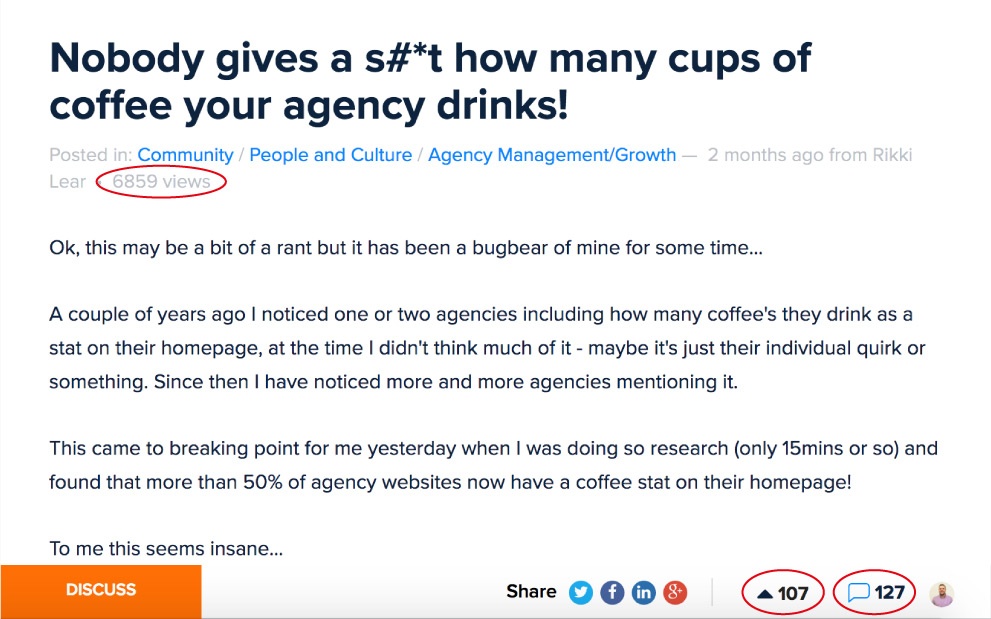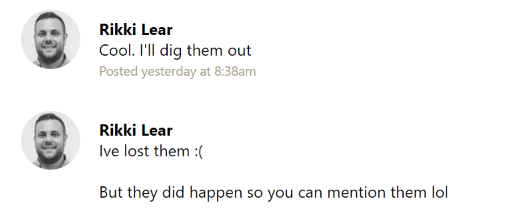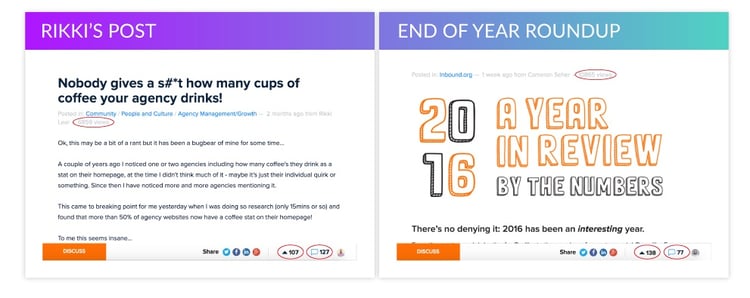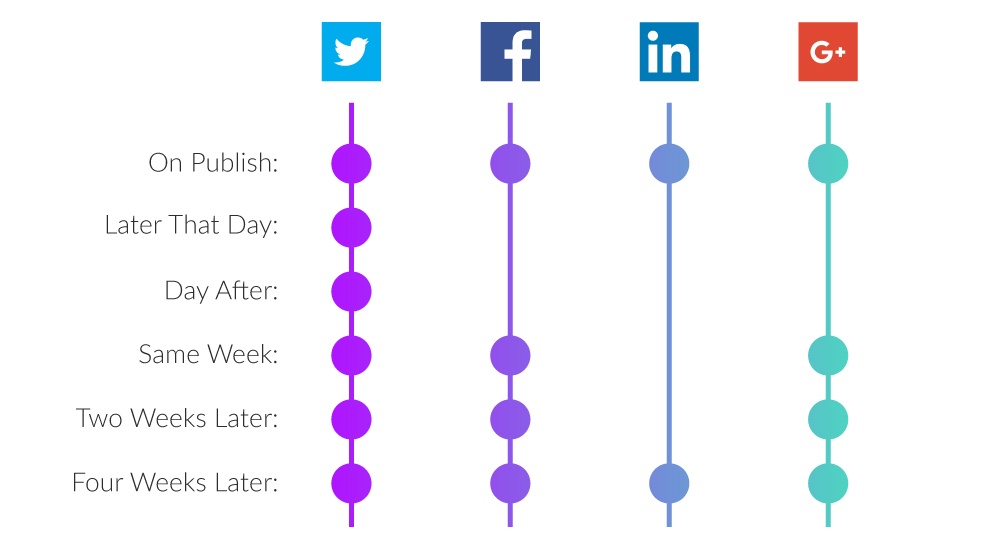Whilst pinning all of your marketing hopes on it might be as sensible a plan as "winning the lottery" is a career move (something an ex-student once told me in all sincerity), at least wondering how to make a blog go viral is a decent move. A Digital 22 director, Rikki, had some success recently and here's our findings.

What We Did
As a {*pauses for effect*}... Platinum HubSpot Agency we - wait, no applause? [Ed. Note: Get on with it.] - we of course run a blog which we share and outreach to various sources, plus we occasionally also do things like host HubSpot user groups. We spend the majority of our time working on our clients' campaigns more than we do our own. We also like to try and stay involved in the online chat amongst inbound marketers on websites such as inbound.org.
And, a couple of months ago, Rikki put a post on inbound.org titled "Nobody gives a s#*t how many cups of coffee your agency drinks!".
And it took off.
What Happened
The post got up towards 7,000 views, drew 127 comments (and counting) and was upvoted over a hundred times. You can see those stats in the red circles:

It ended upgaining and holding a position at the top of the first page of posts very quickly. If you aren't familiar with inbound.org, for this to happen it means that the post is engaging discussion and gaining interest, a bit like on Reddit.
The post was then included in the weekly inbound.org "What's being talked about this week?" roundup email.
The post eventually got mentioned in the popular website's end of year round up. Which was cool.

There was debate, discussion, empathy and brainstorming, in equal measure, in the comments section of the post. And only two or three of those posts were jokes by myself playing on the fact that I love drinking coffee and Rikki doesn't, or debate on another office cliche; the office dog being on the Meet The Team page.
(Shout to all the Chief Biscuit And Cuteness Executives.)
Inbound.org also sent an email out about the post itself - something which has only happened a small handful of times all year - and they used in some of their paid promotion on social.
Rikki said he would dig the links out to these and here's what he said...

Anyway, all this ended up drawing nearly 7,000 views, 107 upvotes of the post itself (and countless more in the 127 comments). That's a lot of interaction for a few hundred word long opinion post on a forum.
Why We Think What Happened, Happened
These are impressive stats, especially when compared to the fact that the own website's end of year roundup currently has over 10,000 views and less comments than Rikki's post (77 to Rikki's 127).

But why did people interact with it so much?
Well, it follows what we think makes for shareable content:
- It's emotive.
- It has a clear opinion and doesn't sit on the fence.
- It's NOT afraid to be confrontational (though polite enough to not actually swear).
- It was posted in the right place at the right time.
- It was written for an audience primed to share or interact with it.
- It was shared socially.
- It used an effective content vehicle (in this case, inbound.org).
And in this theory of ours, there's a lot of overlap with some pretty weighty studies by big content marketing players - such as this one, by Andrea Lehr of Fractl which landed in my inbox literally whilst I was planning this very blog post, and Why People Share by CoSchedule co-founder Garrett Moon.
In her post, Andrea Lehr has quoted Chip and Dan Heath, brothers who study the science behind viral content and she's broken down their "SUCCESs model" and applied it to viral content. The model originally featured in the pair's book Made To Stick: Why Some Ideas Survive and Others Die....
It states that succesful ideas, thoughts, movements, campaigns and (of particular importance to us) content should be in line with SUCCESs:

In the particular example of Rikki and his post about nobody giving a s#*t how many cups of coffee your agency drinks, what we here at Digital 22 try to target with our most shareable posts were particularly prevalent.
Be Emotive
Putting the disguised taboo language to one side (we'll come to that), the post is emotive because it's directed firmly at the reader.
It's about your agency.
Or if you know it doesn't apply to you personally, you can share it in order to prove that you aren't the one doing the annoying thing in question, but you know someone who does. This builds the sharer's perceived authority.
Also, nobody cares about that thing that you thought was cool. You aren't cool. Nobody cares about you.
Even though it's just a blog post, emotions are stirring from that.
Because the "Us and Them" divide that the title's semantics create is emotive on its own. And the tone continues (and develops) throughout the rest of the post.
This is likely to have contributed massively to the level of engagement the post generated.
Personally, I have a hunch that evoking positive emotions is likely to promote more sharing from your network of existing readers*, but potential negativity is going to draw more "Yes!"/"No way!" commentary. It depends what the goal for your own blog post is.
*We've seen this on posts promoting positive company news, recently.
Clear Opinion
Clearly Rikki puts a strong opinion forward in the post. This means that people can either hold the same view and pass it on or comment along in support - or, if they hold the opposite view, they are likely to engage to let the writer know, "Woah, hold on! We do it because x, y and z."
Especially if you ask them to.

Having different opinions doesn't mean you're being nasty to your readers. Though you can be confrontational.
Confrontational
If you want a post to go viral, confront the popular norm, if you wholeheartedly don't agree with it. Don't just toe the mainstream party line, just because everyone else is, because, well, everyone else already is, so why will your blog post stand out?
But don't try to go against the grain if you don't truly believe in what you're saying, because it will show and people won't buy it.
Instead, be confrontational in a way that encourages discourse and debate. Do it intelligently.
Rikki's titles politely swore when saying "nobody gives a s#*t", so this set a confrontational, attention grabbing tone.
But the content of the post itself was reasoned, level and welcomed discussion. And asked the audience to engage and discuss what they think about agency websites which include a counter of coffees the agency has drunk.
Audience Primed For Sharing
It was posted on a site with an engaged, responsive community of readers. And it was a topic which was 100% relevant. All good inbound marketers are looking to improve their own techniques, styles, practices and habits. That's why the community on inbound.org made such a good audience.
So once discussion started on the post, people wanted to take part and add their two penneth, for or against. Or as digressions.
That's because the topic was relatable and tangible to the audience. This made them more likely to share and engage.
Shared
As part of the inbound process, it was shared repeatedly in order to make sure it had the best chance of being seen by our target audience. It was shared internally via email and also by the guys at inbound.org in their roundup email. And on Digital 22 social media accounts.
We always suggest doing this.
Make sure to share it at the times and in a way which resonates with your target persona(s). Will they want to share a work related post when checking Facebook during an advert break of a Friday night film, at home? Or will they be more likely to share it when waiting for a meeting to start at 11.02am on a Thursday?
The answer could surprise you, so make sure you research your industry and persona's social habits and share accordingly.

Right Place Right Time On An Effective Content Vehicle
And inbound.org proved to be a very effective content vehicle. There's a large community of readers there who are engaged and active on the topic, as we said.
Unless you have a strong hold on the online community in your own field, it's likely that your own blog isn't inundated with comments and maybe even views. In this instance, utilising someone else's readership - like Rikki did on inbound.org and Andrea Lehr did on CoSchedule - is a great way of getting your great content in front of more readers.
Timing probably had a part to play on the post being included in the end of year roundup. It went live a couple of months ago; so was recent enough to be favourited or noted as a potential inclusion and still be fresh in the mind when deciding what made the cut, but just far enough in the past to have fallen out of the consciousness of someone coming in cold to the end of year post (as in, it won't be appearing on the same page latest posts page).
Posting it in this right place and at the right time, sharing on social (when the audience is likely to be engaged and open to responding) makes sure your great posts get the response they deserve.
How To Make A Blog Go Viral
All of those ingredients were present in Rikki's post which went viral.
Granted, it might only have been viral within the inbound community - as opposed to someone of the moment like Elijah Quashie, a.k.a. The Chicken Connoisseur, whose early Christmas 2016 present was going viral in the mainstream, so much so that he appeared on ITV news and did this - but Rikki's post went viral to a totally relevant audience.
And that is how you end up with some productive phonecalls.
The content, first and foremost, was relevant, interesting and engaging to its audience. If it isn't those things, it won't have the weight to gain some viral traction.
- Be relevant
- Be interesting
- Be engaging
But that alone may not be enough.
To make a blog go viral, follow those criteria, but also try to harness the reach and influence of true authority figures.
It could be a guest post on another site (which Rikki's was) or contact influencers in your field on social media for enhanced sharing.
If you trust the quality of your content, there's nothing lost when asking for leading voices to take a look and requesting their feedback. They might end up sharing it to their many followers.
But A Blog Is Just One Part Of The Inbound Process
As said, right from the off, pinning all your hopes on trying to produce a blog post which goes viral would be foolhardy. Shoot for the stars, by all means, but don't expect to be able to publish a single blog that does all of the above and expect the world to visit your site.
Blogging is just one tool that a full inbound marketing campaign relies on. If you'd like some free templates to get started on everything inbound, press the button below.
Real Growth. Real Impact.
'Should I use HubSpot?' 32 fundamental reasons why you should
21 cost-effective marketing campaigns you can create right now
Breeze: Everything you need to know about HubSpot's powerful AI
INBOUND 24 learnings and updates
Google Search API leaks: All you need to know [LIVE BLOG]
The top 6 marketing challenges of 2024
Inbound vs outbound marketing: What's the difference?
See why enterprises choose Avidly
Let’s build your HubSpot success story
Compelling final call to action - with accompanying link to Contact page





![Google Search API leaks: All you need to know [LIVE BLOG]](https://www.avidlyagency.com/hs-fs/hubfs/cloud.jpg?width=400&height=225&name=cloud.jpg)


